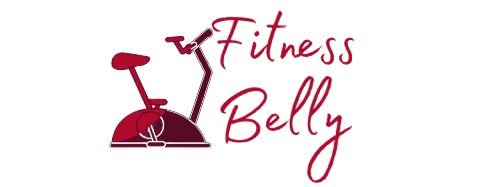It all boils down to efficiency, precision, movement proficiency, consistency, progression, and devotion to the process if you want to benefit from any workout or activity. Compound workouts put your entire system under stress, producing the finest results regardless of whether your objective is to develop your upper or bottom body.
Since having sturdy, toned legs might be challenging, most people skip working out their legs entirely. However, if you concentrate on the best lower body workouts for athletes and work extremely hard, you could have powerful legs and an athletic build.
So what are the best leg exercises? They target multiple muscle groups to load and refine muscle patterns during multi-joint actions.
Not every exercise will help you build muscle. So is HIIT a muscle builder? While HIIT may be less effective in boosting muscle strength, it does have the ability to help you look sculpted. Sure, every activity can lead to a certain outcome, but to stay on the right course, you must be aware of your objectives and limitations.
The Benefits of Lower Body Exercises
It’s easy to become preoccupied with developing the arms or shoulder muscles and forget your lower body.
This can eventually result in an imbalanced and vulnerable-to-injury physique. Instead, you can gain from strengthening your lower body by adopting a football player leg workout. The regimen guarantees:
- Better balance and agility: Working out your legs can improve your mobility and strengthen your lower body.
- Running quicker: Lower body strength training increases your VO2 max, power, and running efficiency, contributing to a more rapid and productive pace.
- Decreased muscle instabilities: By working out your lower body, you may significantly strengthen muscle imbalances and the connective tissue surrounding your lower body joints.
20 Lower Body Exercises for Athletes
The lower body produces the main source of energy and power. Let’s look at 20 lower-body power exercises for athletes.
Kettlebell Swing
The power, stamina, and strength of your glutes and hamstrings can all be enhanced with kettlebell swings. It also strengthens all of your body’s stabilizing muscles.
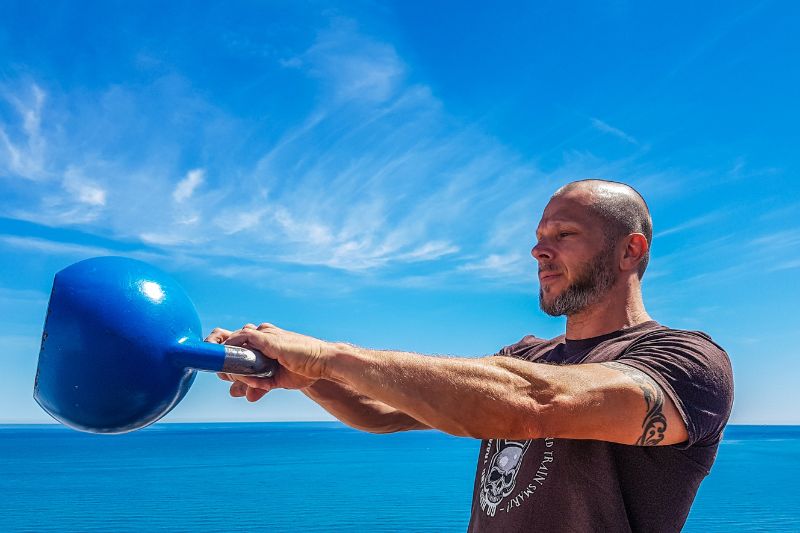
Start by placing your feet farther apart than shoulder-width to perform the kettlebell swing while standing.
- Directly in front of you, put the kettlebell about a foot away.
- Lie back and grab the kettlebell.
- Push your chest up while squeezing your armpits.
- Hold the kettlebell above your knees as you hike it behind you.
- Your hips should move forward. Swing the kettlebell by utilizing the momentum.
- Squeeze your quads and glutes to complete the exercise. Repeat in a loop.
Donkey Calf Raise
Exercises that offer a stretch at the bottom position, along with a greater range of motion (ROM) and the capacity to add load, are necessary to develop and build the calves.
- Start by selecting your desired setup for donkey calf rearing.
- Affix your hands to the step’s edge, tilt back at the hips, and position your feet’s balls there.
- After waiting for approximately three to four seconds, gradually bring your legs as close as you can to the ground.
- Squeeze your calves at the apex of the movement as you lift your heels as high as possible.
- Repeat by gradually lowering yourself.
Box Jump
The box jump is one of the best thigh muscle workouts.
- Start by assuming a tall, athletic stance in front of a strong plyometric box between 18 and 36 inches tall and has a suitable landing zone before performing the box jump.
- Swiftly lower yourself into a quarter squat stance with your arms stretched at 90 degrees in front of your body.
- Jump on the box after firmly stretching the ankle, knee, and hip, then gently descend in a proper athletic stance.
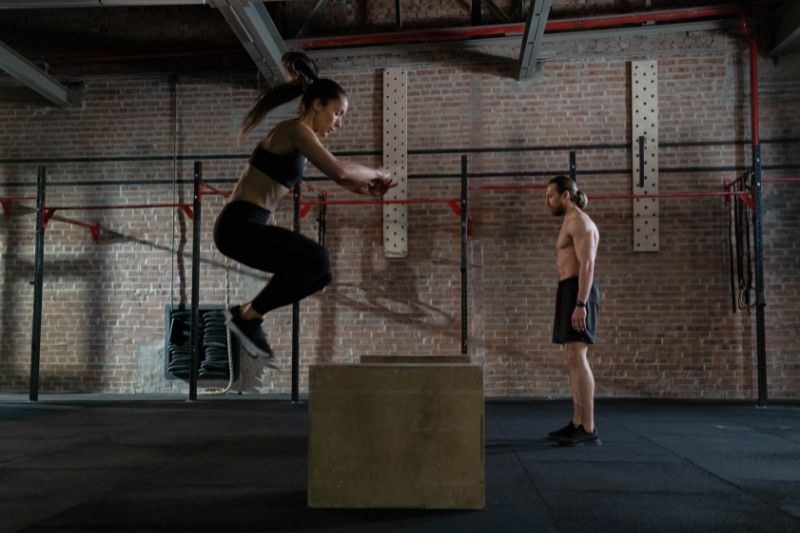
Jump Squats
This plyometric workout helps you develop your quads and calves, increase your explosiveness, and boost your vertical leap.
- Begin in a standard squat stance, push yourself up as quickly as possible, and jump as high straight as possible.
- Once you’ve landed safely, repeat the movement.
If you become tired of doing standard jump squats, opt for the box jumps.
Trap Bar Deadlift
Performing deadlifts with a trap bar is a fantastic alternative for athletes or lifters who want to concentrate on strength with a lower risk of having a lifting injury.
- Begin by bending down and gripping the trap bar on either side to perform a trap bar deadlift.
- Maintain a high chest posture, tighten your shoulder blades, and press your feet into the ground until lockout.
- As the weights approach the floor, gradually hinge back, adjust, and do it again.
Barbell Back Squat
You can perform a barbell back squat in four easy steps.
- Step off the rack with a barbell firmly gripped around your upper back.
- Stand with your feet hip- shoulder-width off each other, with your toes pointing outward slightly.
- While ensuring a good upper body posture, gently bend the knees and hips parallel to each other.
- Maintain your legs and chest, and aggressively straighten your hips and knees to return to the beginning position, ramping up through the midfoot and sole.

Barbell Front Squat
The barbell must be placed and snugly clasped around your torso and clavicles, then with the elbow kept in a raised, solid rack angle for this squat version.
- Place your feet hip-width apart, with the toes gently pointing out.
- While maintaining a good upper body position, free your knees and slide your hips back to enable your hips and knees to bend into a parallel thigh alignment.
- Stretch your knees and hips strongly while ramping up through the mid-foot and heel returning to the beginning posture, maintaining your knees out and chest up.
Rear Foot Elevated Single Leg Squat
Although strenuous, this exercise can be an excellent complement to a lower-body regimen. It helps develop a unilateral foundation and provides an incentive for performance improvement. It can be completed by loading dumbbells and kettlebells in various positions.
- Place your front foot slightly ahead of your body and your back foot slightly beneath the shin level.
- Bend both your front and rear knees into a parallel thigh alignment. Maintain a load through the mid-foot and heel parallel to your front leg and vertical shin.
- Maintaining appropriate posture, aggressively return the front leg’s knee and hip to the starting position.
Lunges
Since they train the front and back leg muscles simultaneously, lunges are great leg workouts for athletes. Being on one leg while moving slowly to maintain balance also provides terrific aerobic exercise.
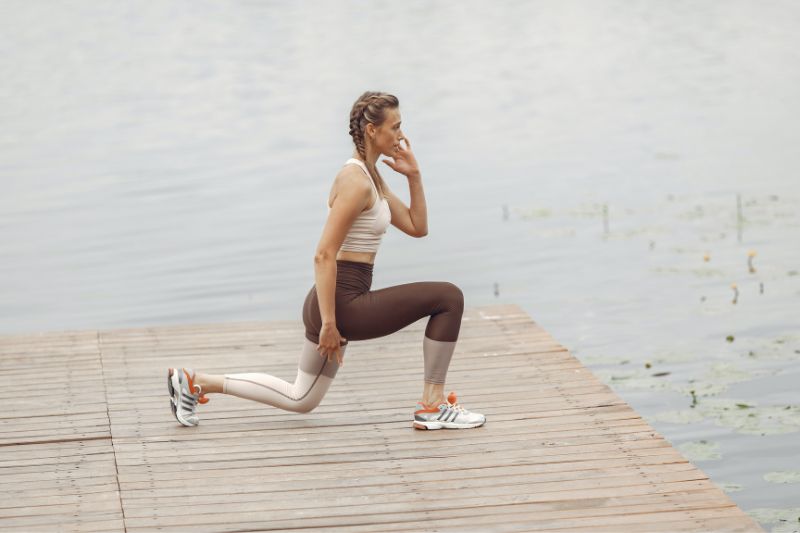
- Start by standing up straight and placing your feet hip-width apart.
- While squatting down, lunge forward with one leg until your rear knee is a few inches off the ground.
- Keep your posture upright during this movement by lifting the heel of this foot and putting it firmly into position.
The lunge can be performed in various ways, such as the reverse lunge, walking lunge, and side lunge. In general, this is among the best lower body exercises available.
Lunge Combo: Lateral + Transverse
Different implements can be fitted onto this combo workout to push the body in various planes and ranges of motion.
- Take a broad lateral step to initiate this workout, then concurrently bend the knee and hip into a parallel thigh alignment with your toes facing forward.
- Maintain your lead leg straight and your trail leg extended. Apply pressure off the laden leg and then revert to the beginning position.
- You must take a rotating step at a 90-degree angle and engage the same leg similarly for the second section of this exercise.
This exercise requires a higher hip movement range across the hips to achieve depth and return to the initial position in a single motion.
Barbell Hip Lift
This is an excellent way to lift heavy objects without needing to worry about placing undue strain on your lower back or spine while simultaneously working the hamstrings, glutes, and the overall lower body.
- With a pad around your waist, begin by reclining on the ground.
- Next, cross your pelvis with a barbell slightly above your waist.
- Hold the barbell with your hands slightly wider than hip-width and legs firmly nestled beneath your torso.
- Your hips should be forcefully extended to their maximum height while maintaining a neutral spine and keeping good ground engagement with the lower and upper back.
- Return the bar to its initial position while controlling its descent.
Glute-Hamstring Raise
The glute-ham raise (GHR) is a fantastic workout to strengthen your hamstrings’ eccentric muscles and grow strong glutes.
- Start by setting the GHR until the feet are stable before performing the glute-hamstring raise.
- On the center of the pad, place your quads. Ensure there’s adequate room for you to stoop.
- Maintain a straight body while bending your knees at 90 degrees.
- Next, stretch your knees while you press your toes against the pad.
- As you progressively drop your torso forward until it’s horizontal, fold your arms over your body.
- Constrict your hamstrings to get back to the beginning position. Restart and continue.
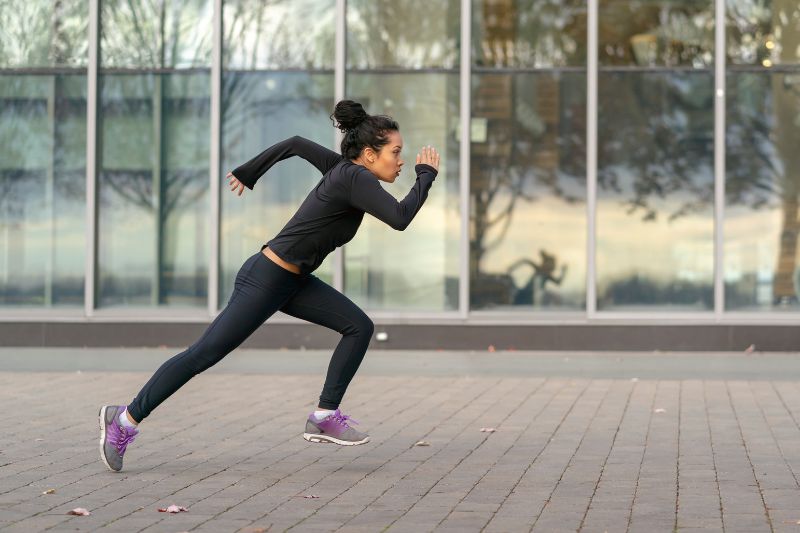
Sprints
Sprints are a fantastic exercise for developing your lower body and core muscles. The glutes are used initially to accelerate swiftly, followed by the hamstrings and quadriceps as you approach your top speed.
Many lifters neglect or choose not to perform this underrated muscle builder, yet it should be a part of any effective program. Sprinting might result in new advances if the body is unaccustomed to it because it stimulates the release of testosterone, which eases bodybuilding.
Sprints also contribute to building strong legs.
Romanian Deadlift
The Romanian Deadlift has many advantages despite being a more challenging lower-body exercise. The advantages include increased gluteal and hamstring capacity, improved balance, diminished muscle imbalances, and muscular hypertrophy.
- Raise one foot off the ground to do the Romanian deadlift.
- While bending the working knee, find the right balance on the rooted foot. Try not to spin the hip that’s working upward while keeping your shoulders down, hips hinged back, and chest up.
- Hinge till your belly button faces the floor and your hamstring stretches.
- After stabilizing, go back to where you were before and repeat.
Once you’re at ease, you can increase weight by holding a kettlebell or dumbbell on one side.
Side Lunge
The frontal axis is where side lunges build strength, balance, and equilibrium. This exercise also increases the flexibility and strength of your adductors.
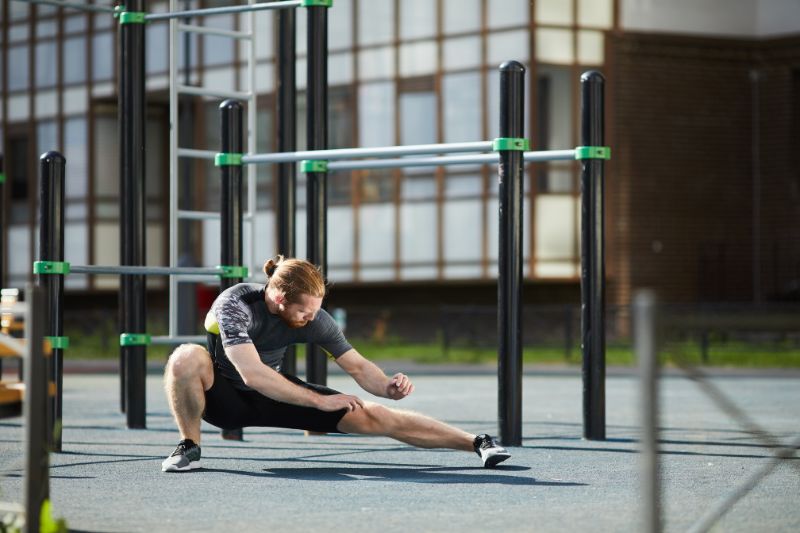
- Begin by assuming a front-loaded dumbbell position to prepare for the side lunge.
- After that, take a tall stance and point the toes forward with the feet clasped. Your left leg should be extended wide to the side.
- Reverse your hip to the left.
- Maintain a straight right leg with your toes pointed forward.
- Put your left foot down firmly. Go back to the beginning place.
Either perform all the rounds on one side, then perform on the other, or switch sides.
Goblet Squats
The key muscles that goblet squats work are your glutes, hamstrings, and quadriceps.
- Begin by putting a kettlebell or other heavy item in front of you and holding it with both hands.
- Then, lower yourself as if you were ready to sit on a chair in your head.
- As you complete this exercise, maintain your upright posture to avoid injuries.
Bike Riding
Consider routinely riding a bike to develop powerful legs.
However, you should ride quickly because long-distance cyclists’ legs tend to be slightly twiggy. The quicker you cycle, the better. Try to ride for about 20 minutes three times each week for optimal results.
Hip Thrust
The hip thrust increases the strength and mass of the glutes.
- Start by assuming a seated position with your back against the bench’s edge parallel to you.
- Roll a weighted barbell into the valley of the hips while cushioning your pelvis.
- Push your back and feet toward the bench once the barbell has been fastened.
- A straight line between your upper torso and hips is important, as well as the shoulder blades being positioned on the bench.
When stretching into lockout and lowering your hips toward the floor, maintain your upper body steady.
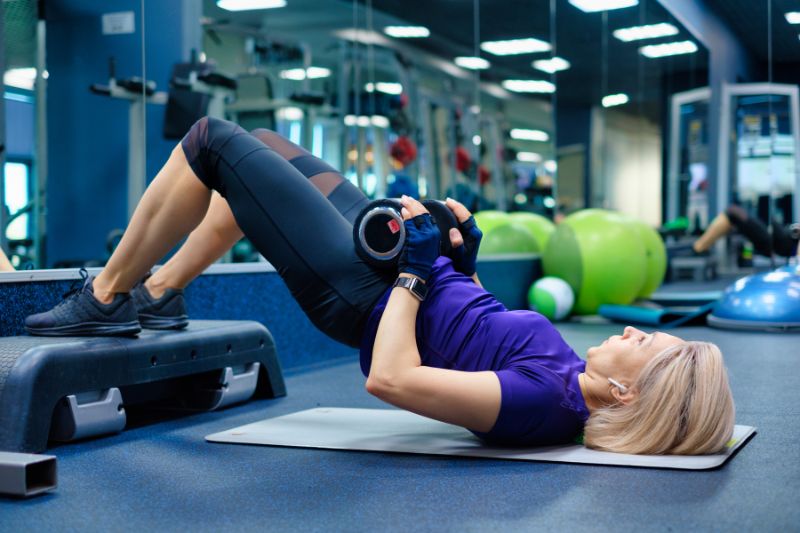
Pistol Squat
The Pistol Squat is an intensive unilateral exercise that improves lower body motion techniques, equilibrium, and single-leg endurance.
- Start standing on one leg with the toes pointing forward and/or slightly turned out.
- Point your toes forward while flexing your front leg. Prepare for your descent by contracting your hip flexors and core.
- As you carefully sit back into a squat, be sure your weight is equally distributed on foot on the ground. Make sure your torso is leaning slightly forward.
- Once you’ve reached the depth you want, press through the floor with just one leg. To ensure maximum effort, also tense your core.
- Establish a solid and supported standing stance on the active leg and repeat.
Ice skater
Ice skaters imitate a person skating on ice. This exercise improves braking and lateral force and is an excellent cardiovascular workout.
- Stand on one leg while bending the other leg at the knee to do the ice skating. With the leg behind you, leap to the side.
- Go down on the other leg. Stick your soft knee into the landing.
- Restart by landing on your starting foot and jumping sideways.
- Repeat this back and forth for the specified number of times or duration.
How to Warm Up Before a Workout
To prepare the muscles and joints for the task, it’s crucial to warm up the lower body with mobility and core exercises. This increases blood flow to the muscles, helps you focus, and prepares your body to lift bigger weights.
Make an effort to warm up for less than five to ten minutes. The lengthier your pregame, the more severe your workout will be.

Some of the dynamic lower body warm-up exercises include:
- Butt kicks 60 seconds
- Side shuffle: 60 seconds
- Run in place: 90 seconds
- Mountain climbers: 30 seconds
- Side-to-side squats: 60 seconds
- Modified jumping jacks: 60 seconds
- Reverse lunge front kick: 60 seconds
You might also consider a cheap pre-workout supplement that can boost energy, enhance exercise performance, and promote muscle growth. However, if you’re concerned about does pre-workout make you poop, practice warm-up exercises that resemble some of the motions you’ll make when working out instead.
How Important a Healthy Diet Is
Physical activity has many positive effects on your health, regardless of whether you participate in competitive sports, leisurely sports, or yoga. Exercise and feeding practices work together to maximize your workout routine and enhance athletic performance.
To maintain a healthy diet, you should:
- Be mindful: Your health may suffer if you don’t consume adequate micronutrients, minerals, vitamins, and other nutrients. Eat a variety of vegetables and fruits, lean proteins, essential fats, whole-grain carbohydrates, and water.
- Fuel up: Ensure that your diet plan includes enough nutrient-dense calories to allow you to exercise while avoiding injuries and maintaining good health.

- Increase carbohydrate intake: When you engage in prolonged, intense exercise, your body benefits from carbohydrates. In actuality, you require more carbohydrates the more active you are. Choose nutritious carbohydrates like brown rice, quinoa, whole-grain bread and pasta, sweet potatoes, fruits, and vegetables.
- Replenish with proteins: They’re crucial since they supply your body with the essential amino acids needed for muscle growth and repair. Fish and poultry are both excellent sources of protein. Beans, peanuts, and chickpeas are among the legumes available to vegetarians and vegans. The same can be said for eggs, Greek yogurt, cheese, and tofu.
- Do not disregard fats: Fat supplies energy and aids in vitamin absorption. Select unsaturated fats only. Avocado, canola, olive oils, flaxseed, and nuts are excellent sources.
What Muscles Are Hardest To Build?
Regardless of how balanced your diet and exercise regimen are, some muscle groups have a higher or lower chance of developing muscle growth over time. They include:
- Calf muscles: The calves are composed primarily of slow-twitch fibers, which makes them less receptive to resistance training.
- Abdominal muscles: Your abs comprise a sizable portion of your core muscles, although muscle development in this region is challenging.
- Hamstrings: They need high loads and a lot of training because of their size, yet many people choose to undertrain them by concentrating on other areas.
Conclusion
It’s essential to train your lower legs and ankles while completing any lower-body exercise routine. Maintaining sufficient strength and range of motion in the four ankle movements can positively affect general movement patterns.
Lower body power exercises are quite helpful. They will hasten the development of your lower-body strength if you do them correctly.
So how do you plan lower body exercises to develop athletic legs? You’ll most likely want to build your schedule around your lower body sessions because they’re so physically taxing.
To put it another way, if you would like to squat two times weekly and deadlift once per week, evaluate your recovery requirements and incorporate upper body exercises as necessary.
Many weightlifters choose to leg press on the occasions they squat and overhead press on the occasions they deadlift. But as seen, many great workout splits are available for strength training.
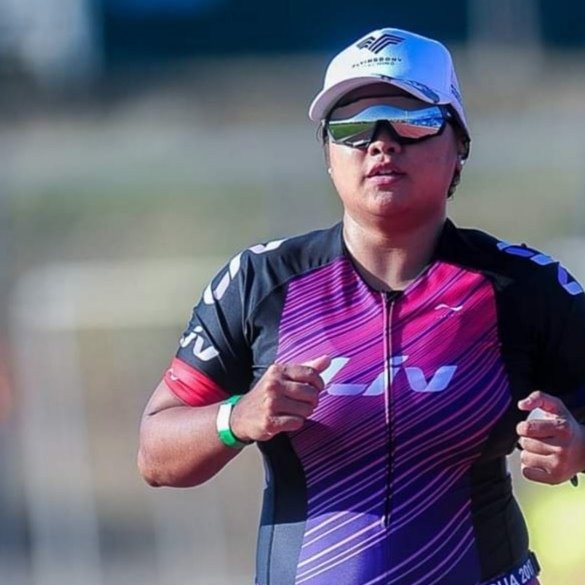
I’m a triathlete and life coach, with a focus on holistic health, fitness & women’s issues.
I also write about my gastronomic adventures and my love for the outdoors.
